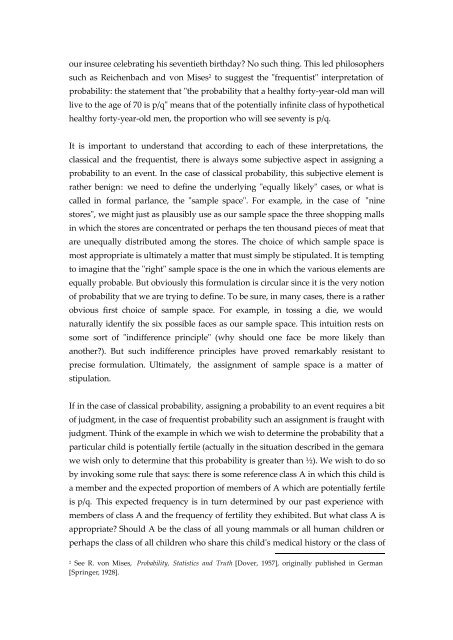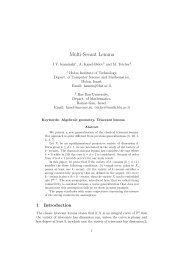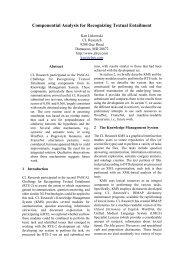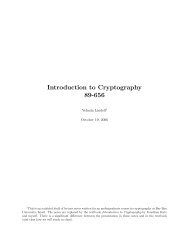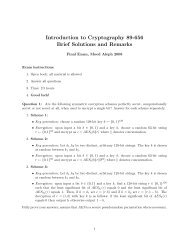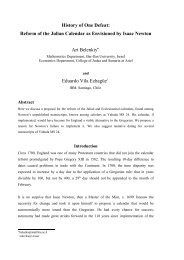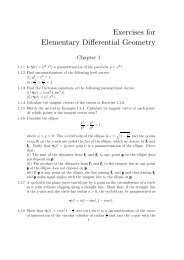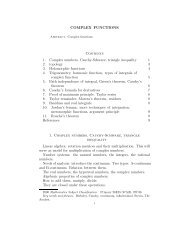Resolving Uncertainty: A Unified Overview of Rabbinic Methods
Resolving Uncertainty: A Unified Overview of Rabbinic Methods
Resolving Uncertainty: A Unified Overview of Rabbinic Methods
Create successful ePaper yourself
Turn your PDF publications into a flip-book with our unique Google optimized e-Paper software.
our insuree celebrating his seventieth birthday? No such thing. This led philosophers<br />
such as Reichenbach and von Mises 2 to suggest the "frequentist" interpretation <strong>of</strong><br />
probability: the statement that "the probability that a healthy forty-year-old man will<br />
live to the age <strong>of</strong> 70 is p/q" means that <strong>of</strong> the potentially infinite class <strong>of</strong> hypothetical<br />
healthy forty-year-old men, the proportion who will see seventy is p/q.<br />
It is important to understand that according to each <strong>of</strong> these interpretations, the<br />
classical and the frequentist, there is always some subjective aspect in assigning a<br />
probability to an event. In the case <strong>of</strong> classical probability, this subjective element is<br />
rather benign: we need to define the underlying "equally likely" cases, or what is<br />
called in formal parlance, the "sample space". For example, in the case <strong>of</strong> "nine<br />
stores", we might just as plausibly use as our sample space the three shopping malls<br />
in which the stores are concentrated or perhaps the ten thousand pieces <strong>of</strong> meat that<br />
are unequally distributed among the stores. The choice <strong>of</strong> which sample space is<br />
most appropriate is ultimately a matter that must simply be stipulated. It is tempting<br />
to imagine that the "right" sample space is the one in which the various elements are<br />
equally probable. But obviously this formulation is circular since it is the very notion<br />
<strong>of</strong> probability that we are trying to define. To be sure, in many cases, there is a rather<br />
obvious first choice <strong>of</strong> sample space. For example, in tossing a die, we would<br />
naturally identify the six possible faces as our sample space. This intuition rests on<br />
some sort <strong>of</strong> "indifference principle" (why should one face be more likely than<br />
another?). But such indifference principles have proved remarkably resistant to<br />
precise formulation. Ultimately, the assignment <strong>of</strong> sample space is a matter <strong>of</strong><br />
stipulation.<br />
If in the case <strong>of</strong> classical probability, assigning a probability to an event requires a bit<br />
<strong>of</strong> judgment, in the case <strong>of</strong> frequentist probability such an assignment is fraught with<br />
judgment. Think <strong>of</strong> the example in which we wish to determine the probability that a<br />
particular child is potentially fertile (actually in the situation described in the gemara<br />
we wish only to determine that this probability is greater than ½). We wish to do so<br />
by invoking some rule that says: there is some reference class A in which this child is<br />
a member and the expected proportion <strong>of</strong> members <strong>of</strong> A which are potentially fertile<br />
is p/q. This expected frequency is in turn determined by our past experience with<br />
members <strong>of</strong> class A and the frequency <strong>of</strong> fertility they exhibited. But what class A is<br />
appropriate? Should A be the class <strong>of</strong> all young mammals or all human children or<br />
perhaps the class <strong>of</strong> all children who share this child's medical history or the class <strong>of</strong><br />
2<br />
See R. von Mises, Probability, Statistics and Truth [Dover, 1957], originally published in German<br />
[Springer, 1928].


